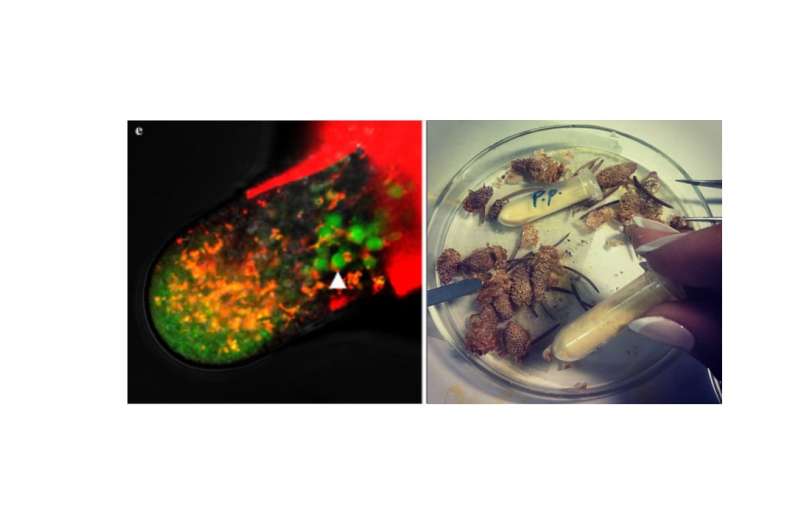Hydrogen peroxide assists sexual reproduction in spruce

Plant physiologists from MSU have proved for the first time that dangerous reactive oxygen species that are often considered by-products of energy generation in cells are required by conifers to fertilize egg cells. Experiments with blue spruce (Picea pungens) pollen led to the discovery of a protein that makes the whole system work. The scientists believe that the obtained data will lead to the optimization of conifer forest restoration. The results of the study were published in Plant Reproduction.
"The study of sexual reproduction in conifers is in its early stage, and many of its aspects are practically unknown," says co-author Maria Breygina, a senior scientific researcher at MSU. "These studies are of high fundamental importance, as the pollen of conifers is a more ancient object with directional growth compared to that of flowering plants."
Flowering plants have flowers with stamens distributing the pollen and pistils where it is fertilized. Cross-pollination is usually more advantageous for a plant, as it helps to increase genetic diversity. The seeds in flowering plants are formed inside an ovary which, in turn, forms a fruit (that is why flowering plants are also called angiosperms). However, gymnosperms (of which conifers are the best-known group) also have mechanisms for cross-pollination. In conifers, these are cones that are actually modified sprouts. The cones of conifers are diclinous; male cones are relatively small and produce pollen that is distributed by wind, and female cones are bigger and form seeds. After reaching the female cone, pollen sticks to special liquid (in pines and spruce) or small hairs (as in Douglas fir).
Having landed in the right place (on a pistil in flowering plants or under a seed scale in gymnosperms), pollen starts to grow, forming a pollen tube. Through this tube, sperm cells reach to egg cell to fertilize it. In flowering plants, the second sperm fuses with a central cell to form endosperm (a nutritional part of the seeds, for example, as in wheat seeds). That is why this fertilization type is called double fertilization.
All these processes were described long ago, but modern science is focused on their molecular and biochemical aspects. It has been recently established that reactive oxygen species (ROS) play a key role in pollen germination in angiosperms. ROS are neutral or negatively charged particles in which oxygen has an unpaired electron. ROS include peroxides (in particular, hydrogen peroxide) and radicals, such as superoxide radical O2-.
An unpaired electron makes ROS highly reactive. If a lot of ROS is formed within a cell, the consequences may be severe. These compounds may affect the balance of complex biochemical reactions, damage membranes, DNA, and other parts of cells. That is why, regardless of their origin, ROS are often considered dangerous by-products that need to be neutralized as quickly as possible. Still, certain cells synthesize them in small quantities and use as a messenger. Due to the ambiguous nature of these compounds, it is extremely important to study the useful functions of ROS, such as their role in plant fertilization.
Plant physiologists from MSU were the first to study the role of ROS in pollen germination in conifers (namely, blue spruce) and found out that pollen grains secrete hydrogen peroxide and O2- into the environment before germinating. Later on hydrogen peroxide gradient is formed in the pollen tube, i.e. its concentration is increased in the tip. This gradient seems to be necessary for the tube to grow to the egg cell, as well as to support the membrane potential (negative charge) gradient (which is described in conifers for the first time), though these gradients do not seem to be related directly.
The scientists also found out what protein regulates this process. It turned to be NADPH-oxidase located in cell membranes. This protein is in charge of moving electrons out of the cell and the formation of extracellular superoxide. ROS interconvert quite quickly, O2- turns into peroxide that re-enters the cell. Due to this process hydrogen peroxide is distributed gradiently in the pollen tube. Experiments have shown that after NADPH oxidase suppression pollen grains do not germinate, and pollen tubes become unable to grow. Therefore, fertilization doesn't take place.
"The results of this and further studies may be used to optimize forest restoration, especially fir trees, cedars, pines, and silver-firs, as well as their selection and forming a collection of forest breeds in Russia," said Maria Breygina.
All the authors of the article study or work at MSU. Maria was in charge of drafting the article and processing experimental data obtained by Ph.D. student Nikita Maksimov and undergraduate student Anastasiya Evmenyeva. The idea was developed by Igor Ermakov, Doctor of Biology, professor of the plant physiology department, and the coordinator of the study.
More information: Nikita Maksimov et al, The role of reactive oxygen species in pollen germination in Picea pungens (blue spruce), Plant Reproduction (2018). DOI: 10.1007/s00497-018-0335-4
Provided by Lomonosov Moscow State University




















